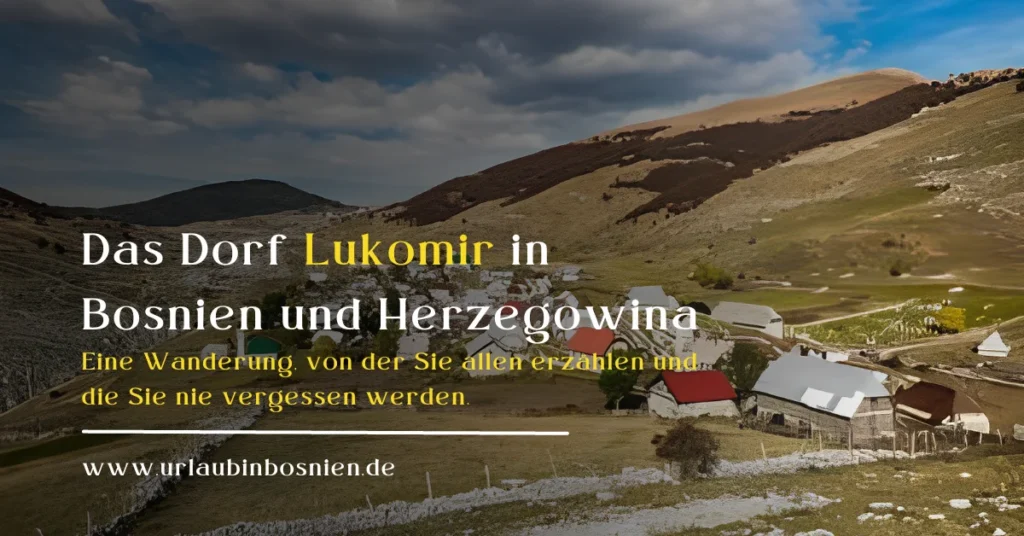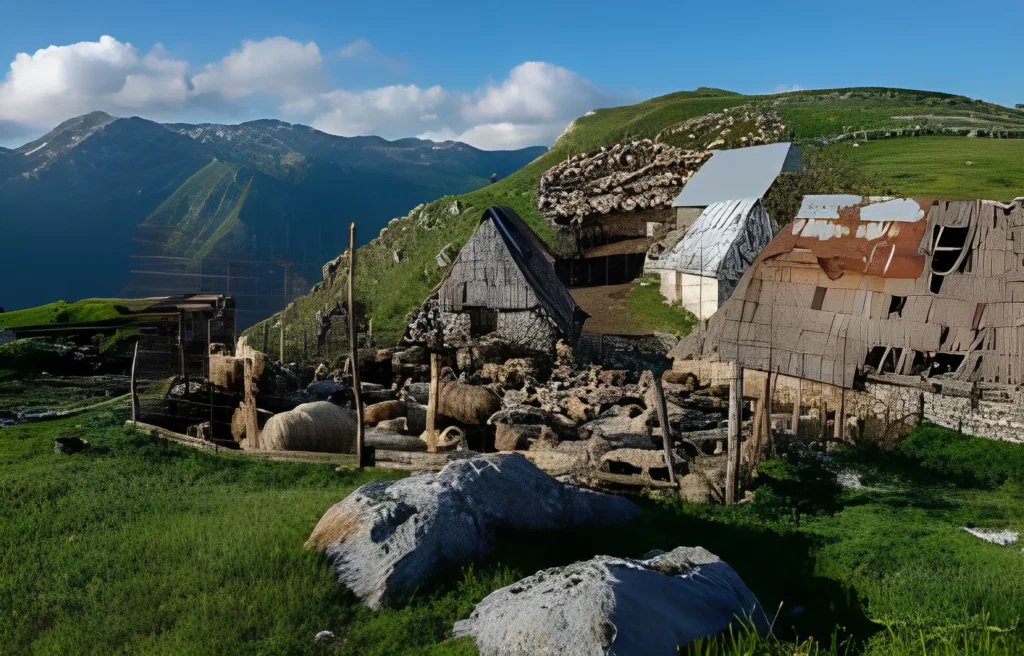The village of Lukomir in Bosnia and Herzegovina
Lukomir, also known as the last Bosnian village, is a mountain village located on the southern slopes of Bjelašnica at an altitude of 1495 meters, making it the highest inhabited place in Bosnia and Herzegovina, the only one above 1300 meters. Based on the gravestones found in the village, which date back to the 14th and 15th centuries, it is believed that the village was inhabited hundreds of years ago.
Today Lukomir has no permanent residents, but is a seasonal settlement (inhabited from spring to autumn), while in the winter months it is uninhabited due to extreme living conditions.
The population is mainly engaged in livestock breeding and agriculture. Lukomir is like a living ethnographic museum where the customs of nomadic tribes are practiced and the traditional way of life of the Dinaric mountain dwellers is preserved. It is an important part of the historical, cultural, architectural and spatial heritage of Bosnia and Herzegovina, and the tombstones scattered around the village suggest that it was inhabited in the 14th and 15th centuries.

The village is unique for its stone houses covered with oak, spruce and beech forests. The houses have a square base with a fireplace in the middle, and small windows are set into the stone walls. When constructing the houses, the residents adapted to the peculiarities of the terrain and the harsh mountain climate. Of the 50 houses in the village, 21 are inhabited in the summer, and on sunny days up to 4,000 sheep graze in the pastures around Lukomir, which are kept in stone pens surrounded by fences at night.
From the viewpoints above the village, the view extends to the ridge of Visočica mountain, which descends into the 800-meter-deep gorge of the Rakitnica River, which is the deepest in Europe after the gorges of the Tara River, also located in Bosnia and Herzegovina.
National Monument
The village of Lukomir and its landscape have been declared a national monument of Bosnia and Herzegovina and include a total of 96 objects in the village. These include 50 residential buildings, 49 farm buildings and the former school building. Additionally, there is a necropolis, a collection of graves, with 18 tombstones on the cemetery grounds and another necropolis with nine tombstones on the grounds of Jezerine.
In the village, in addition to the houses of the residents and the idyllic picture of life, there is also an ethnographic house where visitors can stay overnight. Every year an increasing number of tourists visit the village of Lukomir and the hospitable people living there.
Why is Lukomir such a special place?

Lukomir is considered the most remote village from civilization in Bosnia and Herzegovina and is only accessible by off-road vehicles or on foot. The best impression you can get when visiting this village and its inhabitants is by hiking there.
Many refer to Lukomir as the last true Bosnian village. Due to its traditional architecture, rich history and long, continuous settlement, Lukomir has been declared one of the longest continuously inhabited villages in Europe by the Historical Architecture Society of Great Britain.
Entering Lukomir is like traveling back in time. But it is more than that. The moment you see the roofs of Lukomir from the top of Mount Obalj, which lies above the 800-meter-deep gorge of the Rakitnica River and is surrounded by green meadows and the outlines of Bjelašnica, it feels like you are the main character in a science fiction movie.
Some houses in Lukomir are over 200 years old. Traditionally built of stone, their roofs were made of cherry wood shingles. Even today you can see these stone houses, and even the renovated ones have retained the spirit of times gone by. Today Lukomir relies largely on tourism; visitors can even stay overnight, and numerous restaurants offer refreshments for those interested in Lukomir and its surroundings.
The tombstones visible in the village prove that Lukomir was inhabited in the 14th and 15th centuries. It was always associated with the nomadic and traditional way of life of the Dinaric mountaineers. Due to the lack of water, the villagers brought their livestock to the green and lush pastures of Lukomir, which over time led to the formation of the village.
Even today, the inhabitants of Lukomir lead a semi-nomadic life, engaged in agriculture, sheep farming and, of course, tourism. Life here goes on from spring to the end of autumn, or as the villagers would say, “from the last snowfall to the first”. Today, Lukomir is a top destination for rural tourism. Visitors can enjoy hospitality and traditional culinary specialties in several taverns.
As a souvenir of their stay in the last Bosnian village, guests can buy handicrafts made by the villagers. Recently built mountaineering huts are fully prepared to receive guests. From here, hikers can walk along the cliffs above the 800-meter-deep gorge of the Rakitnica River that lies below Lukomir. Lukomir is known for its traditional clothing, and even today women wear knitted garments similar to those worn centuries ago.

Umoljani: A village known for its legends

Located at 1275 meters above sea level, the village of Umoljani is associated with fascinating legends. It is a popular destination for hikers exploring the mountain trails leading to Studeni Potok, Lukomir or Rakitnica Canyon.
This picturesque village, located on the Bjelašnica mountain range and about an hour's drive from Sarajevo, combines natural beauty with an authentic rural atmosphere. The old shepherds' huts create a distinctive and charming image of the surroundings.
For hiking enthusiasts, Umoljani is a paradise on earth. From this village you can set off on an adventure and explore mountain trails leading to Studeni Potok, Lukomir or even to Rakitnica Canyon. Each trail offers the opportunity to immerse yourself in untouched nature, discover beautiful landscapes and experience the unmistakable spirit of mountain life. The terrain is great for hiking and mountain biking.
Behind the village of Umoljani lies the valley of Studeno Polje, through which the famous Studeni Potok flows. Its uniqueness lies in the fact that the stream resembles a snake when viewed from a certain distance, which has given rise to a fascinating legend. The story says that a long time ago a dragon in the form of a snake came to this area from the Rakitnica Canyon and wanted to devour the villagers.
Since it was in the shape of a snake, its twisted body formed the stream we see today, amazingly resembling the movement of a snake in the sand. The residents of Umoljani fled to the nearby Posiljak Hill and prayed to God for rescue. Their prayers were heard, and the dragon was turned into a stone, which still stands on the Posiljak Hill today.
The views you will see in the valley are equally enchanting in all seasons. If you are a bit more adventurous and skilled, you can hike up to the point where Studeni Potok flows into the Rakitnica River and enjoy the view of the powerful waterfall cascading into the Rakitnica Canyon.
Umoljani is also rich in authentic shepherds' huts, used by shepherds in the summer while their cattle graze in the pastures. Just 200 meters from the village entrance you will find a necropolis with about 20 tombstones.
Interestingly, some of these tombstones are built into the foundations of a unique mosque in Umoljani. This mosque with its tin minaret has been declared a national monument of Bosnia and Herzegovina. It is believed that during World War II, the famous Jewish book “Sarajevo Haggadah” was hidden in the foundations of the mosque.
Umoljani comes alive especially on weekends, when people from Sarajevo and tourists come to enjoy restaurants surrounded by stunning mountain landscapes. You can indulge in traditional Bosnian cuisine, rich in authentic flavors, from dishes prepared with locally grown ingredients to homemade specialties. Sitting on the restaurant terrace, you can relax and enjoy breathtaking views, surrounded by magnificent mountain peaks.






